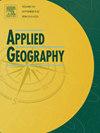Exploring the associations of socioeconomic characteristics and distance decay effects with two-Steps spatial interaction model
IF 5.4
2区 地球科学
Q1 GEOGRAPHY
引用次数: 0
Abstract
The Spatial Interaction (SI) model is a prominent tool for predicting trip flows based on the distance decay effect. Despite extensive discussions on spatial heterogeneity and spatial structure, existing SI models are still exploring ways to incorporate local distance decay variations within small urban areas. Furthermore, non-spatial factors, such as socioeconomic characteristics, are typically underestimated in SI and other travel flow prediction models. To tackle these issues, this study introduces a novel two-step SI model that enhances travel flow predictions. This study utilises a k-means clustering algorithm to group areas based on residents' socioeconomic characteristics, then calibrates the localised distance-decay parameter in the origin-specific gravity model for each group and predicts the travel flows. Demonstrated by a case study of the Greater London Area (GLA), we uncovered local distance decay patterns in commuting trips and explained their associations with spatial structure and non-spatial factors using census data. Most importantly, the results proved that our two-step SI model could significantly improve the accuracy of flow predictions without considerably increasing computational complexity.
利用两步空间相互作用模型探讨社会经济特征与距离衰减效应的关系
空间相互作用(SI)模型是基于距离衰减效应预测出行流的重要工具。尽管对空间异质性和空间结构进行了广泛的讨论,但现有的SI模型仍在探索如何纳入小城市区域的局部距离衰减变化。此外,非空间因素,如社会经济特征,在SI和其他旅游流预测模型中通常被低估。为了解决这些问题,本研究引入了一种新的两步SI模型来增强旅行流预测。本研究采用k-means聚类算法,根据居民的社会经济特征对区域进行分组,然后对每个分组的起源比重模型中的局部距离衰减参数进行校准,并预测出行流量。以大伦敦地区(GLA)为例,揭示了通勤出行的局部距离衰减模式,并利用人口普查数据解释了其与空间结构和非空间因素的关联。最重要的是,结果证明,我们的两步SI模型可以显著提高流量预测的准确性,而不会显著增加计算复杂度。
本文章由计算机程序翻译,如有差异,请以英文原文为准。
求助全文
约1分钟内获得全文
求助全文
来源期刊

Applied Geography
GEOGRAPHY-
CiteScore
8.00
自引率
2.00%
发文量
134
期刊介绍:
Applied Geography is a journal devoted to the publication of research which utilizes geographic approaches (human, physical, nature-society and GIScience) to resolve human problems that have a spatial dimension. These problems may be related to the assessment, management and allocation of the world physical and/or human resources. The underlying rationale of the journal is that only through a clear understanding of the relevant societal, physical, and coupled natural-humans systems can we resolve such problems. Papers are invited on any theme involving the application of geographical theory and methodology in the resolution of human problems.
 求助内容:
求助内容: 应助结果提醒方式:
应助结果提醒方式:


